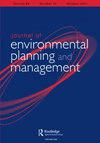The support of Multilateral Development Banks to renewable energy projects in developing countries
IF 3.6
4区 经济学
Q1 DEVELOPMENT STUDIES
Journal of Environmental Planning and Management
Pub Date : 2023-10-11
DOI:10.1080/09640568.2023.2263904
引用次数: 0
Abstract
AbstractMultilateral Development Banks (MDBs) are extensively involved in the Paris Climate Agreement and play a key role in climate finance. However, the amounts recently channeled to carbon-based projects may raise doubts about this involvement. This empirical approach seeks to explore whether MDB participation actually favors renewable energy projects in developing countries, aligning with their commitment to this Agreement. An empirical analysis is conducted to explore the determinants of MDBs’ participation in energy infrastructure projects developed in 64 countries using data from 2011 to 2018 obtained from the World Bank’s Private Participation in Infrastructure Database. The results reveal that MDBs’ participation is higher in renewable energy projects, confirming their commitment to clean energy; however, this is not confirmed by the amount of financial support provided.Keywords: climate financelimited dependent variable modelsMultilateral Development Banksrenewable energy projectsJEL classification codes: H54Q54F35 Disclosure statementNo potential conflict of interest was reported by the author.Supplemental dataSupplemental data for this article can be accessed online at https://doi.org/10.1080/09640568.2023.2263904.Notes1 MDBs are international financial institutions that assist developing countries in reducing poverty, fostering economic growth, and tackling global challenges. MDBs operate as cooperative entities owned and funded by member countries. Their development finance activities include concessional and non-concessional loans, leveraging capital, risk mitigation, co-financing, technical assistance and policy advise.2 The MDBs included in this analysis are the World Bank Group, the European Investment Bank, the Asian Development Bank, the European Bank for Reconstruction and Development, the Islamic Development Bank, the Inter-American Development Bank, the African Development Bank and the new MDBs established in 2015: the Asian Infrastructure Investment Bank (initiated by China) and the New Development Bank (BRICS bank).3 We follow the International Renewable Energy Agency (IRENA) and classify hydropower as a renewable source. The largest sources of GHG emissions for hydropower are the construction of the facilities, and biomass decomposition from reservoir flooding (Steinhurst, Knight, and Schultz Citation2012) but large hydropower plants produce fewer greenhouse gas emissions when compared with fossil fuel-based plants.4 In the PPI database, government support may be Direct support - capital subsidy, revenue subsidy or in-kind (lands, for instance); Or Indirect support, in the form of guarantees (e.g., payment guarantee, debt guarantee, revenue guarantee, exchange-rate guarantee).5 Because only the percentage of private participation in each project is available on the database, it is not possible to use the financial amounts provided by the private sector.6 Variables such as “control of corruption” and “government effectiveness” from the WGI dataset were also tested, but due to collinearity issues these variables were dropped from the analysis.7 Differences in the number of projects, between Table 2 and Table A.4 or Table A.5 (online supplementary material), are due to projects that are being classified in the database with MDBs' support but without the information on the financial amount (not available).8 VIF is an indicator of how much of the inflation of the standard error could be caused by collinearity. As a rule of thumb, values above 10 should be a cause for concern and must be corrected.9 With annual data, the number of lags is typically small in order not to lose degrees of freedom (Wooldridge Citation2013).10 Another possibility is to use a Tobit model, that estimates the financial support provided by MDBs in only one step, taking directly into account its censored nature. Nevertheless, because it relies on strong assumptions of normality and homoscedasticity of the error term, better results are often provided by more general models, used here.11 To enrich the analysis, several interaction terms between the “renewable” dummy variable and other macroeconomic, financial, and institutional controls were tested but without statistical significance achieved (results not presented).12 MDBs’ participation in energy projects, besides funding, can encompass several distinct possibilities: operational assistance, technical and professional advice, political assistance, risk mitigation instruments (e.g., guarantees and insurance against political risks).Additional informationFundingThe author declares that no funds, grants, or other support was received during the preparation of this manuscript.多边开发银行对发展中国家可再生能源项目的支持
摘要多边开发银行广泛参与《巴黎气候协定》,在气候融资中发挥着关键作用。然而,最近流入碳基项目的资金可能会引发对这种参与的质疑。这种实证方法旨在探讨多边开发银行的参与是否实际上有利于发展中国家的可再生能源项目,并与它们对本协定的承诺相一致。本文利用世界银行私人参与基础设施数据库2011年至2018年的数据,对64个国家的多边开发银行参与能源基础设施项目的决定因素进行了实证分析。结果表明,多边开发银行对可再生能源项目的参与度较高,证实了其对清洁能源的承诺;但是,所提供的财政支助数额并不能证实这一点。关键词:气候融资限制变量模型多边开发银行可再生能源项目jel分类代码:H54Q54F35披露声明作者未报告潜在利益冲突。补充数据本文的补充数据可通过https://doi.org/10.1080/09640568.2023.2263904.Notes1在线获取多边开发银行是帮助发展中国家减少贫困、促进经济增长和应对全球挑战的国际金融机构。多边开发银行作为成员国拥有和资助的合作实体运作。它们的发展融资活动包括优惠和非优惠贷款、撬动资本、降低风险、联合融资、技术援助和政策咨询这一分析包括世界银行集团、欧洲投资银行、亚洲开发银行、欧洲复兴开发银行、伊斯兰开发银行、美洲开发银行、非洲开发银行以及2015年新成立的多边开发银行:亚洲基础设施投资银行(由中国发起)和新开发银行(金砖国家银行)我们遵循国际可再生能源机构(IRENA),将水电列为可再生能源。水电温室气体排放的最大来源是设施的建设和水库洪水产生的生物质分解(Steinhurst, Knight, and Schultz citation, 2012),但与基于化石燃料的发电厂相比,大型水电站产生的温室气体排放量更少在生产者价格指数数据库中,政府支持可以是直接支持——资本补贴、收入补贴或实物(例如土地);或间接支持,以担保的形式(如付款担保、债务担保、收入担保、汇率担保)由于数据库只提供私人参与每个项目的百分比,因此不可能使用私人部门提供的财政数额WGI数据集中的“腐败控制”和“政府效率”等变量也进行了测试,但由于共线性问题,这些变量被从分析中删除表2与表A.4或表A.5(联机补充材料)之间项目数量的差异是由于在多边开发银行的支持下在数据库中分类的项目,但没有关于财务金额的信息(无法获得)VIF是一个指标,表明有多少标准误差的膨胀可能是由共线性引起的。根据经验,超过10的值应该引起关注,必须加以纠正对于年度数据,滞后的数量通常很小,以便不失去自由度(Wooldridge Citation2013)另一种可能性是使用Tobit模型,该模型只需要一步就可以估算多边开发银行提供的资金支持,并直接考虑其审查性质。然而,由于它依赖于对误差项的正态性和均方差的强假设,因此本文使用的更一般的模型通常会提供更好的结果为了丰富分析,对“可再生”虚拟变量与其他宏观经济、金融和体制控制之间的几个相互作用项进行了测试,但没有取得统计显著性(结果未提出)多边开发银行参与能源项目,除提供资金外,还可包括几种不同的可能性:业务援助、技术和专业咨询、政治援助、风险缓解工具(例如,担保和政治风险保险)。作者声明在撰写本文期间没有收到任何资金、资助或其他支持。
本文章由计算机程序翻译,如有差异,请以英文原文为准。
求助全文
约1分钟内获得全文
求助全文
来源期刊
CiteScore
9.10
自引率
5.10%
发文量
155
期刊介绍:
Journal of Environmental Planning and Management has already established itself as a leading forum for up-to-date scholarly but accessible papers on all aspects of environmental planning and management. With contributions from leading international authors, the Journal publishes influential, high quality papers -an essential feature whether you are a subscriber, reader, contributor or all three. The Editors and International Editorial Advisory Board are drawn from around the world and are committed to encouraging researchers and practitioners to contribute to multidisciplinary and international debate in the field. The central aim is to focus on the integrated planning and management of the environment.

 求助内容:
求助内容: 应助结果提醒方式:
应助结果提醒方式:


